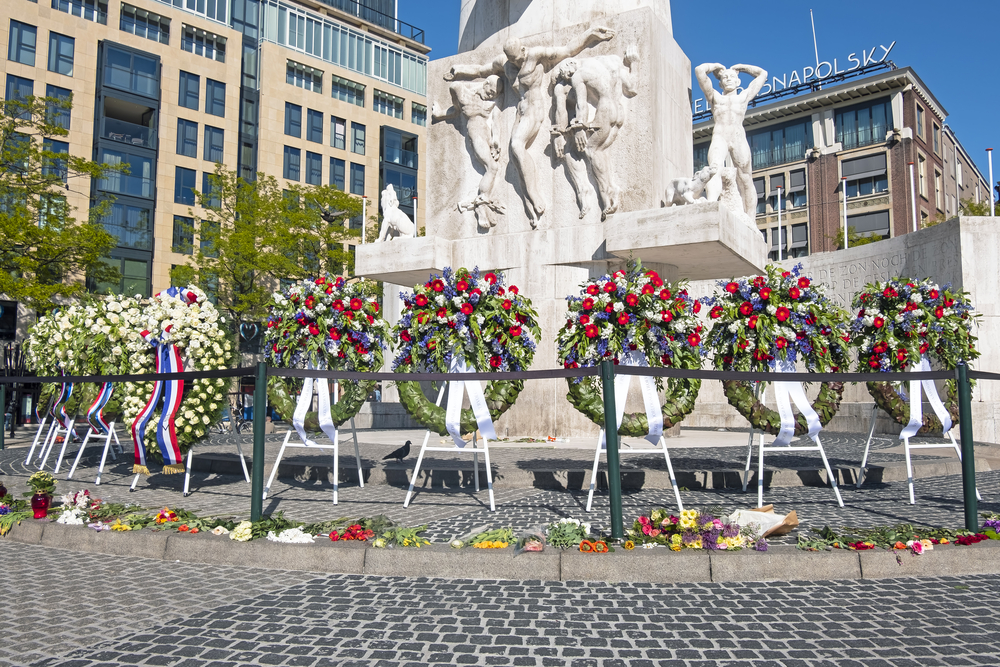The Netherlands celebrates Dodenherdenking, also known as Remembrance Day, on May 4 to commemorate civilians and soldiers worldwide who lost their lives in World War II and other conflicts.
At 8:00 PM on May 4, the country observes a two-minute silence.
Why two minutes of silence on Remembrance Day?
According to NPO Radio 1, the tradition originated in a 1916 memorial service hosted by Cape Town’s mayor for World War I soldiers in South Africa.
READ MORE | 8 unmissable movies about the Netherlands in WWII
The actions of Cape Town’s mayor were recognised across Europe.
The first minute is for those who died, and the second minute is for those who returned from battle, as well as “where the war had an impact for generations to come”.
I’m blown away. At a busy restaurant in the Netherlands on their Remembrance Day, EVERY SINGLE PERSON in that restaurant observed the 2 minute silence at 2000hrs this evening. This happens across the entire country. We could take a leaf out of their book. 🇳🇱 #lestweforget2022 pic.twitter.com/HmFvjj5MA1
— Kath (@KathKathfisher1) May 4, 2022
Many European countries continue to observe a two-minute silence during Remembrance Day.
How does the Netherlands celebrate Remembrance Day?
Apart from observing a two-minute silence, Dutch people often hang the Dutch flag in their windows or at half-mast on flagpoles from 6 PM until sunset, marking the mourning period.

The Netherlands holds an official commemorative service at the National Monument in Amsterdam on Dam Square. The King and Queen attend, give speeches, and lay wreaths.
What should you do as an international during Remembrance Day?
Many municipalities hold commemorations across the country, the biggest and busiest being at Amsterdam’s Dam Square.
Citizens also hold memorials at war cemeteries in The Hague. Other large cities host commemorations in squares or outside the city hall.
READ MORE | Liberation Day in the Netherlands: what you need to know about May 5
Unable to attend? No problem, people don’t really go out of their way to attend commemoration ceremonies, so don’t worry if you can’t.
Instead, many people pay their respects by observing a two-minute silence on May 4 and pausing for a few minutes.
How do you usually pay your respects during Remembrance Day? Tell us in the comments below.





In Canada, one minute of silence is observed at the 11th hour of the 11th day of the 11th month, at the end of morning ceremonies in every community from sea to sea to sea. Everything stops on radio and TV and places of business. At one time all businesses closed for the day, but that is no longer the case. We also call it Remembrance Day.
.November 11 was the date the Treaty of Versailles was signed near Paris in 1918 to end World War I. It was thought to be the war to end all wars. Now the date also applies to all subsequent wars in which Canadians have fought: WW II, Korea and Afghanistan, and even the Boer War.a. It’s the date we also honour Canadians who serve with United Nation Peacekeeping Forces.
At the morning ceremony, wreaths are laid at the base of a war memorial , or cenotaph, usually made of stone, in the heart of every town and city. You will hear bagpipes, military bands, prayers, hymns and speeches, then just before the minute of silence, a lone bugler plays ‘taps’. Many people often move on to visit war museums or go to Canadian Legion halls, where Veterans meet year-round, for a hot lunch and an afternoon of visiting with old friends and comrades.
In the weeks leading up to Remembrance Day, veterans and their support groups set up in shops and public places to collect donations and distribute a replica of a red poppy flower, to be worn on the lapel. This is also the symbol of Remembrance Day in Great Britain. It refers to a famous poem from WWI about the poppies that grow wild near the graves of fallen soldiers; “In Flanders fields the poppies grow, upon the crosses row on row…”. The entire poem is usually recited at the morning ceremony. It was written by a Canadian Army doctor, John McCrae, and taught to every school child in the country.
This is also a time to review Canada’s valiant history at war. There are usually excellent documentaries aired on National tv. Canada basically won its independence, step by step, from Britain by helping it to avoid defeat in the two world wars. Tens of thousands of Canadians died as a result.
In the 1970s and 80s, attendance at Remembrance Day ceremonies started to wane. But that quickly changed when two things happened:. As it got close to the 50th anniversary of the end of World War II in 1985, many European countries like Holland invited veterans to return to the places they had liberated, and even covered the expenses. On live television, Canadians got to see their veterans being honoured at a parade through Nijmegen, in some ways better than at home.
Then, shortly after, the first Canadian woman ever killed in action, died in Afghanistan. She was the daughter of university professors and was married to another soldier. Since then, Canadians participate as fully as possible in Remembrance Day.
Impressive. Us Americans could never, and not just because of time zones.